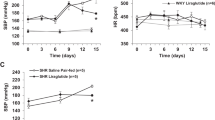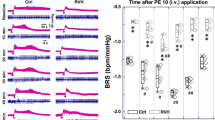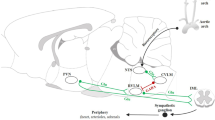Abstract
Hypertension is well-known to often coexist with diabetes mellitus (DM) in humans. Treatment with sodium-glucose cotransporter 2 (SGLT2) inhibitors has been shown to decrease both the blood glucose and the blood pressure (BP) in such patients. Some reports show that SGLT2 inhibitors improve the BP by decreasing the activities of the sympathetic nervous system. Therefore, we hypothesized that SGLT2 inhibitors might alleviate hypertension via attenuating sympathetic nervous activity. Combined SGLT2/SGLT1 inhibitor therapy is also reported as being rather effective for decreasing the BP. In this study, we examined the effects of SGLT2 and SGLT1 inhibitors on the bulbospinal neurons of the rostral ventrolateral medulla (RVLM). To investigate whether bulbospinal RVLM neurons are sensitive to SGLT2 and SGLT1 inhibitors, we examined the changes in the neuronal membrane potentials (MPs) of these neurons using the whole-cell patch-clamp technique during superfusion of the cells with the SGLT2 and SGLT1 inhibitors. A brainstem–spinal cord preparation was used for the experiments. Our results showed that superfusion of the RVLM neurons with SGLT2 and SGLT1 inhibitor solutions induced hyperpolarization of the neurons. Histological examination revealed the presence of SGLT2s and SGLT1s in the RVLM neurons, and also colocalization of SGLT2s with SGLT1s. These results suggest the involvement of SGLT2s and SGLT1s in regulating the activities of the RVLM neurons, so that SGLT2 and SGLT1 inhibitors may inactivate the RVLM neurons hyperpolarized by empagliflozin.

SGLT2 and SGLT1 inhibitors suppressed the activities of the bulbospinal RVLM neurons in the brainstem-spinal preparations, suggesting the possibilities of lowering BP by decreasing the sympathetic nerve activities. RVLM, rostral ventrolateral medulla. IML, intralateral cell column. aCSF, artificial cerebrospinal fluid.
This is a preview of subscription content, access via your institution
Access options
Subscribe to this journal
Receive 12 print issues and online access
$259.00 per year
only $21.58 per issue
Buy this article
- Purchase on Springer Link
- Instant access to full article PDF
Prices may be subject to local taxes which are calculated during checkout





Similar content being viewed by others
References
Ghezzi C, Loo DD, Wright EM. Physiology of renal glucose handling via SGLT1, SGLT2 and GLUT2. Diabetologia. 2018;61:2087–97.
Aguilar-Gallardo JS, Correa A, Contreras JP. Cardio-renal benefits of sodium-glucose co-transporter 2 inhibitors in heart failure with reduced ejection fraction: mechanisms and clinical evidence. Eur Heart J Cardiovasc Pharmacother. 2022;8:311–21.
Erdogan MA, Yusuf D, Christy J, Solmaz V, Erdogan A, Taskiran E, et al. Highly selective SGLT2 inhibitor dapagliflozin reduces seizure activity in pentylenetetrazol-induced murine model of epilepsy. BMC Neurol. 2018;18:81.
Takeda K, Ono H, Ishikawa K, Ohno T, Kumagai J, Ochiai H, et al. Central administration of sodium-glucose cotransporter-2 inhibitors increases food intake involving adenosine monophosphate-activated protein kinase phosphorylation in the lateral hypothalamus in healthy rats. BMJ Open Diabetes Res Care. 2021;9:e002104.
Al Hamed FA, Elewa H. Potential therapeutic effects of sodium glucose-linked cotransporter 2 inhibitors in stroke. Clin Ther. 2020;42:e242–9.
Kawasoe S, Maruguchi Y, Kajiya S, Uenomachi H, Miyata M, Kawasoe M, et al. Mechanism of the blood pressure-lowering effect of sodium-glucose cotransporter 2 inhibitors in obese patients with type 2 diabetes. BMC Pharmacol Toxicol. 2017;18:23.
Reed JW. Impact of sodium-glucose cotransporter 2 inhibitors on blood pressure. Vasc Health Risk Manag. 2016;12:393–405.
Briasoulis A, Al Dhaybi O, Bakris GL. SGLT2 inhibitors and mechanisms of hypertension. Curr Cardiol Rep. 2018;20:1.
Herat LY, Matthews J, Azzam O, Schlaich MP, Matthews VB. Targeting features of the metabolic syndrome through sympatholytic effects of SGLT2 inhibition. Curr Hypertens Rep. 2022;24:67–74.
Wright EM, Loo DDFL, Hirayama BA. Biology of human sodium glucose transporters. Physiol Rev. 2011;91:733–94.
Sano R, Shinozaki Y, Ohta T. Sodium-glucose cotransporters: functional properties and pharmaceutical potential. J Diabetes Investig. 2020;11:770–82.
Pitt B, Bhatt DL. Does SGLT1 inhibition add benefit to SGLT2 inhibition in Type 2 diabetes? Circulation. 2021;144:4–6.
Song P, Huang W, Onishi A, Patel R, Kim YC, van Ginkel C, et al. Knockout of Na+-glucose cotransporter SGLT1 mitigates diabetes-induced upregulation of nitric oxide synthase NOS1 in the macula densa and glomerular hyperfiltration. Am J Physiol Renal Physiol. 2019;317:F207–17.
Rosenstock J, Cefalu WT, Lapuerta P, Zambrowicz B, Ogbaa I, Banks P, et al. Greater dose-ranging effects on A1C levels than on glucosuria with LX4211, a dual inhibitor of SGLT1 and SGLT2, in patients with type 2 diabetes on metformin monotherapy. Diabetes Care. 2015;38:431–8.
de Boer RA, Núñez J, Kozlovski P, Wang Y, Proot P, Keefe D. Effects of the dual sodium-glucose linked transporter inhibitor, licogliflozin vs placebo or empagliflozin in patients with type 2 diabetes and heart failure. Br J Clin Pharmacol. 2020;86:1346–56.
Madden CJ, Sved AF. Rostral ventrolateral medulla C1 neurons and cardiovascular regulation. Cell Mol Neurobiol. 2003;23:739–49.
Oshima N, Kumagai H, Onimaru H, Kawai A, Pilowsky PM, Iigaya K, et al. Monosynaptic excitatory connection from the rostral ventrolateral medulla to sympathetic preganglionic neurons revealed by simultaneous recordings. Hypertens Res. 2008;31:1445–54.
Pilowsky PM, Goodchild AK. Baroreceptor reflex pathways and neurotransmitters: 10 years on. J Hypertens. 2002;20:1675–88.
Oshima N, Onimaru H, Matsubara H, Uchida T, Watanabe A, Takechi H, et al. Uric acid, indoxyl sulfate, and methylguanidine activate bulbospinal neurons in the RVLM via their specific transporters and by producing oxidative stress. Neuroscience. 2015;304:133–45.
Oshima N, Onimaru H, Yamagata A, Itoh S, Matsubara H, Imakiire T, et al. Erythropoietin, a putative neurotransmitter during hypoxia, is produced in RVLM neurons and activates them in neonatal Wistar rats. Am J Physiol Regul Integr Comp Physiol. 2018;314:R700–8.
Arab HH, Safar MM, Shahin NN. Targeting ROS-dependent AKT/GSK-3β/NF-κB and DJ-1/Nrf2 pathways by dapagliflozin attenuates neuronal injury and motor dysfunction in rotenone-induced Parkinson’s disease rat model. ACS Chem. Neurosci. 2021;17:689–703.
Hierro-Bujalance C, Infante-Garcia C, Del Marco A, Herrera M, Carranza-Naval MJ, Suarez J, et al. Empagliflozin reduces vascular damage and cognitive impairment in a mixed murine model of Alzheimer’s disease and type 2 diabetes. Alzheimers Res Ther. 2020;12:40.
Pawlos A, Broncel M, Woźniak E, Gorzelak-Pabiś P. Neuroprotective effect of SGLT2 Inhibitors. Molecules. 2021;28:7213. 26
Poppe R, Karbach U, Gambaryan S, Wiesinger H, Lutzenburg M, Kraemer M, et al. Expression of the Na+-D-glucose cotransporter SGLT1 in neurons. J Neurochem. 1997;69:84–94.
Ishida N, Saito M, Sato S, Tezuka Y, Sanbe A, Taira E, et al. Mizagliflozin, a selective SGLT1 inhibitor, improves vascular cognitive impairment in a mouse model of small vessel disease. Pharmacol Res Perspect. 2021;9:e00869.
Kondo H, Akoumianakis I, Badi I, Akawi N, Kotanidis CP, Polkinghorne M, et al. Effects of canagliflozin on human myocardial redox signalling: clinical implications. Eur Heart J. 2021;42:4947–60.
Author information
Authors and Affiliations
Corresponding author
Ethics declarations
Conflict of interest
The authors declare no competing interests.
Additional information
Publisher’s note Springer Nature remains neutral with regard to jurisdictional claims in published maps and institutional affiliations.
Rights and permissions
Springer Nature or its licensor (e.g. a society or other partner) holds exclusive rights to this article under a publishing agreement with the author(s) or other rightsholder(s); author self-archiving of the accepted manuscript version of this article is solely governed by the terms of such publishing agreement and applicable law.
About this article
Cite this article
Oshima, N., Onimaru, H., Yamashiro, A. et al. SGLT2 and SGLT1 inhibitors suppress the activities of the RVLM neurons in newborn Wistar rats. Hypertens Res 47, 46–54 (2024). https://doi.org/10.1038/s41440-023-01417-5
Received:
Revised:
Accepted:
Published:
Issue Date:
DOI: https://doi.org/10.1038/s41440-023-01417-5
Keywords
This article is cited by
-
Inhibiting SGLTs diminishes sympathetic output by reducing rostral ventrolateral medulla (RVLM) neuron activity
Hypertension Research (2023)



